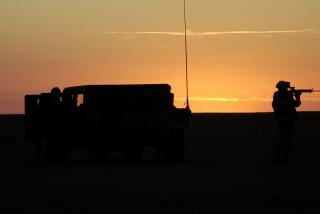Marine Exercise Sends a Message to Milosevic
- Share via
CAMP PENDLETON, Calif. — As debate surges over whether U.S. ground troops should be sent to Kosovo, the Marine Corps on Wednesday staged a large-scale show of the kind of punch its amphibious troops are ready to deliver.
And if certain people in Belgrade happened to see some CNN coverage of the Marines’ ability to use F/A-18s, Cobra gunships and squads of troops armed with M-16s to strike swiftly and decisively, no one here would be displeased.
“If [Slobodan Milosevic] does not appreciate the capabilities of the U.S. Marine Corps, he could make a very foolish mistake,” Sgt. Maj. Richard Forrest said as he watched helicopter Marines stage a mock urban rescue of hostages.
A dozen ships and thousands of sailors and Marines are taking part in a two-week exercise to test, and display, their ability to move personnel and weaponry quickly and to immediately engage an enemy on his own turf, be it mountains or densely populated cities. There are topographic parallels.
“The terrain in Kosovo isn’t much different than Camp Pendleton,” retired Gen. Al Gray, a former Marine Corps commandant, said as he watched the troops go through their paces. “A little cooler and a little taller maybe, but nothing these Marines couldn’t handle.”
Although such exercises are not uncommon for forces from Camp Pendleton and San Diego naval bases, Kernel Blitz ’99 seems to have an extra gusto, what the Marines call up-tempo. Talk of Kosovo is in the air.
“Marines are always ready to go, when the call comes,” said Lt. Col. Pat Garrett, a battalion commander.
And to help send a message to Milosevic, the Marine Corps and Navy have thrown open the exercises for media coverage to a greater degree than in previous exercises.
“Information can be a good deterrent,” said Col. Mark Thiffault, spokesman for Kernel Blitz. “Maybe if someone realizes what he’s doing could cause him some pain, he’ll change his behavior.”
While President Clinton has repeatedly stressed he has no plans to send ground troops to Kosovo, some congressional leaders have urged otherwise.
On Wednesday, at this northern San Diego County base, Marine Corps officials stressed that an amphibious assault force is trained and equipped to reach 150 miles inland in a short period of time.
From ships in the Adriatic Sea, that 150-mile reach covers nearly all of Kosovo and parts of Serbia. Kernel Blitz is designed to test new electronics gear meant to double the reach of an amphibious force through improved communications with ships.
While there is little chance these particular Marines and sailors will see action in the NATO operation in Serbia--their area of responsibility is the Pacific Rim and the Persian Gulf--they reflect the capabilities of Marines from Camp Lejeune, S.C., who are currently on three ships in the Adriatic, awaiting orders.
Kernel Blitz ’99 and the Marine Corps’ eagerness for media coverage could be seen as part of an American campaign to keep Milosevic guessing about what direction American ground troops might take if the conflict continues.
On the weekend, Army Gen. Hugh Shelton, chairman of the Joint Chiefs of Staff, suggested there are many “points of entry” into Serbia, leading to immediate speculation that he was hinting that Army troops could take an overland route from the north through NATO member countries.
A seaborne assault by the Marines would come from the southwest.
Just the threat of a Marine amphibious assault proved to be a tactical advantage during the Persian Gulf War. With U.S. ships and their troops poised for weeks off the Kuwaiti coast, eight Iraqi divisions were pinned down waiting for an assault that never happened.
Although more attention has been given to Army troops in the NATO offensive--including the three American soldiers taken prisoner--Marines went ashore last week into Skopje, Macedonia, to assist with the humanitarian effort for ethnic Albanians fleeing Kosovo.
The Marines are equipped with an innovative piece of computer software that translates English into Albanian, and vice versa.
Under Kernel Blitz, the Navy and Marine Corps are testing various scenarios, including long-range helicopter raids, amphibious landings with Hovercraft, combined land and air strikes, and the deployment of Navy SEALs.
In the latter stages of the exercise, there will also be a reminder that a ground war would most likely lead to American casualties.
The hospital ship Mercy, which saw duty in the Persian Gulf War, will be tested to see if its 1,450 medical personnel can handle 500 simulated casualties over five days.
The test is billed as the largest and most complex medical exercise ever conducted at sea, with Hollywood makeup artists being used to add realism to 300 mock victims and 200 mannequins.
Ground troops, of course, is a term that might be more explicitly translated as young men with rifles. Thousands of such men are taking part in Kernel Blitz and there is a common theme in their comments.
Of a dozen young enlisted Marines interviewed by The Times, every one, when asked, said that, yes, his mother is quite worried that he could be sent to fight in Kosovo.
“I told her to pray for me but not to worry because I’ve been trained,” said Lance Cpl. Eugene Foss of Chicago. “I’m not sure she bought it though. She’s still worried.”
“My mother is worried and I tried to tell her I’d be fine,” said Sgt. Patrick Nance of Bloomington, Ill. “Mothers worry a lot.”
A Navy corpsman attached to a Marine infantry platoon framed the issue as one of responsibility.
“Those people over there are hurting, and we’re not hurting, so it’s up to us to do what we can to help them,” said Kishore Moses, an immigrant from India, his eyes glistening.
More to Read
Get the L.A. Times Politics newsletter
Deeply reported insights into legislation, politics and policy from Sacramento, Washington and beyond. In your inbox twice per week.
You may occasionally receive promotional content from the Los Angeles Times.










